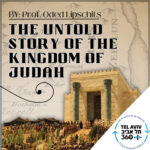X

תל אביב 360 – אוניברסיטת תל אביב: ערוץ הפודקסטים
(B5) The Untold Story of How to Make Renovations in the Temple and How Solomon’s Altar was Replaced with a New Aramaic Altar
/

(B5) The Untold Story of How to Make Renovations in the Temple and How Solomon’s Altar was Replaced with a New Aramaic Altar
Feb 22, 2024 • 00:30:50
Over the centuries of Judah’s existence, the temple in Jerusalem gradually became the focus of the people’s life. However, it is doubtful whether the Jerusalem historiographers had reliable written sources of information about the past of the temple and its history. It was easy for them to describe its construction,…
עדכון זמן הקפצנו אותך לנקודה הקודמת שעצרת
[לקרוא עוד...]
[פחות...]


